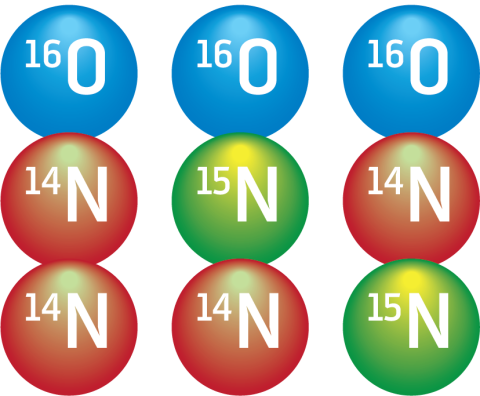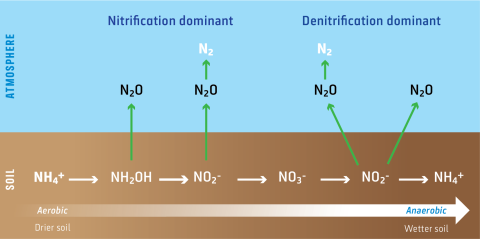Almost half of Aotearoa New Zealand’s CO2-equivalent greenhouse gas emissions come from agriculture, as reported annually by the Ministry for the Environment in its Greenhouse Gas Inventory. This is a much higher proportion than most other countries – globally, agricultural emissions average around 7.5% of a country’s total emissions.
Methane (CH4) accounts for the majority of agricultural emissions in New Zealand and comes mostly from farmed livestock, such as sheep and cattle. These animals naturally produce methane as a by-product of their digestive processes.The other main agricultural greenhouse gas, nitrous oxide (N2O), is produced when nitrogen compounds in urine, manure and fertilisers are broken down by microbes in the soil and released into the atmosphere.
Under the Climate Change Response (Zero Carbon) Amendment Act 2019, New Zealand has set a target to reduce emissions of biogenic methane (methane produced by animals and plants) to 24–47 per cent below 2017 levels by 2050, including to 10 per cent below 2017 levels by 2030. (The reduction target for emissions of all other greenhouse gases is net zero by 2050.)To help achieve the target for reducing biogenic methane, NIWA researchers are working to understand:
- how we can assess and verify agricultural emissions accurately
- how these emissions can be reduced and sustainable farming practices improved.
Research and partnerships NIWA is involved with:
Estimating national emissions: bottom-up meets top-down
New Zealand’s National Inventory Report, compiled each year by the Ministry for the Environment and submitted annually as a commitment to the UN Framework Convention on Climate Change, estimates national greenhouse gas emissions using an agreed ‘bottom up’ accounting method. For methane, this involves modelling production per animal based on dietary intake and relationship to methane production, and then scaling this by the number and types of ruminant livestock across New Zealand.‘Top-down’ greenhouse gas accounting is a powerful and rapidly evolving approach that quantifies greenhouse gas emissions from measurements of their concentrations in the atmosphere at a network of measurement sites. Top-down techniques for quantifying greenhouse gas emissions provide comprehensive evaluation of all gas sources (and sinks) and can provide independent verification and be used to assess how effective of emission reduction strategies are at the national scale.
The use of top-down assessments is becoming international best practice in verification of nations’ greenhouse gas inventories as recommended in Inventory Guidelines produced by the Intergovernmental Panel on Climate Change (IPCC). The World Meteorological Organization (WMO)’s Integrated Global Greenhouse Gas Information system (IG3IS) is coordinating this development of national-scale top-down accounting activity.
CarbonWatch NZ
New Zealand is leading the way in implementation of national-scale top-down greenhouse gas accounting work, through the NIWA-led CarbonWatch NZ programme. This 5-year research programme is funded by the Ministry for Business, Innovation and Employment’s Endeavour Fund. It combines measurements of greenhouse gases in the air above New Zealand with models that tell where those gases have come from. The programme is looking at emissions and uptake of greenhouse gases by cities, farmland and forests. This is enabling the creation of a national top-down record of emissions and sinks.
In 2021 New Zealand’s National Inventory Report included inverse modelling results from CarbonWatch NZ for verifying regional methane emissions for the first time.
MethaneSAT
Satellite-based observations of greenhouse gas emissions are also developing. MethaneSAT is a joint satellite initiative by the United States of America and Aotearoa New Zealand to measure atmospheric methane with unprecedented precision. Its core mission is to tackle climate change by supporting a global reduction in methane emissions.The US science team will focus on methane emissions from oil and gas production across the globe. NIWA is leading the MethaneSAT agricultural emissions research programme, looking at livestock emissions in New Zealand and more generally how the satellite’s data can be used to better understand methane emissions from the agricultural sector.
Estimating emissions at farm scale
Agricultural nitrous oxide (N2O) accounts for around a sixth of New Zealand’s CO2-equivalent greenhouse gas emissions. It is a potent long-lived greenhouse gas that is a by-product of microbial degradation of animal excrement (mainly urine) and of nitrogen fertilisers in pasture soils. The potential for mitigation of N2O emission through in paddock treatment by ‘nitrification inhibitors’ has been trialled in New Zealand in small scale trials. These have the potential dual benefit of reducing nitrate leaching as well as lowering N2O emissions.
As well as small scale trials, it is important to verify that the treatments are effective (i.e. reduce N2O fluxes) at farm scale. NIWA is working on techniques using specialised high-tech instruments to measure N2O in air within a paddock (by a technique known as micro-meteorology). NIWA researchers have developed and verified these micro-meteorological techniques measuring at paddock (hectare) scale as a tool for testing mitigation efficacy. One such innovation is a ‘paddock-scale’ calibration system that releases known quantities of N2O from a spatial array in a paddock and that can be used to test micro-meteorological flux systems. This type of measurement system has been developed to measure and compare two or more hectare-sized treatment plots.
The following research papers provide more information about this work:
- Verification of micrometeorologically determined nitrous oxide fluxes following controlled release from pasture (Animal Production Science 2016)
- The detectability of nitrous oxide mitigation efficacy in intensively grazed pastures using a multiple-plot micrometeorological technique (Atmospheric Measurement Techniques 2013)
Isotopic characterisation
The NIWA gas laboratory has developed methods for precise characterisation of the stable isotopic composition of methane (CH4) and is developing similar capability for nitrous oxide N2O. This powerful tool can provide information about the sources and sinks of the gases being measured.
This article provides background information about stable isotopes and the insights we can glean from them.With new optical cavity laser infra-red spectroscopy instrumentation, NIWA has been examining isotopomers of N2O.
The N2O molecule is configured with 3 atoms as N-N-O. Its most common form is 14N-14N-16O but the isotopomer molecules 14N-15N-16O and 15N-14N-16O also occur naturally. These two isotopomers have the same mass with heavy and light atoms transposed.

The relative abundance of these two isotopomers is determined by the mix of formation processes, which are in turn are strongly influenced by soil moisture levels. Nitrification is dominant in more aerobic conditions and denitrification more dominant in wet anaerobic soils.
The two main formation processes are distinguished by quite different site preference of the isotopomers which we can measure. Understanding the main N2O formation pathways using isotopomers may provide a key to developing strategies to reduce N2O production. It also gives us insights into the impact of mitigation techniques (such as nitrification inhibitors) on overall N2O production.

NIWA has developed procedures to characterise the stable isotopic composition of gases emitted from agricultural soils.
Partnership with NZ Agricultural Greenhouse Gas Research Centre (NZAGRC)
The NZ Agricultural Greenhouse Gas Research Centre (NZAGRC) is a partnership between New Zealand’s leading agricultural greenhouse gas research providers. Its remit is to seek practical solutions for New Zealand farmers to reduce emissions and, in doing this, to contribute world-leading science to the international climate change response.
NZAGRC members:
- AgResearch
- Dairy NZ
- Manaaki Whenua Landcare Research
- Massey and Lincoln Universities
- Pastoral Greenhouse Gas Research Consortium (PGgRc)
- Plant & Food Research
- Scion
- NIWA
In 2008, the NZAGRC developed one of the world’s largest animal chamber facilities at AgResearch in Palmerston North. This facility measures the emissions of individual animals. The chambers quantify the effectiveness of mitigation measures like selective breeding, inhibitors of methane production (in food additives or injections) or specific diets. This work depends on accurate measurements of feed intake and greenhouse gas levels by the chamber instrumentation.
NIWA contributed to its development by designing and specifying instrumentation and developing sampling protocols. We now carry out annual calibrations of the facility (most recently in January 2021).The size of the methane facility is set to increase to allow bigger batches of cattle to be assessed. It is expected that this field of research will intensify in coming years in the quest for methane mitigation solutions for the agricultural industry.


